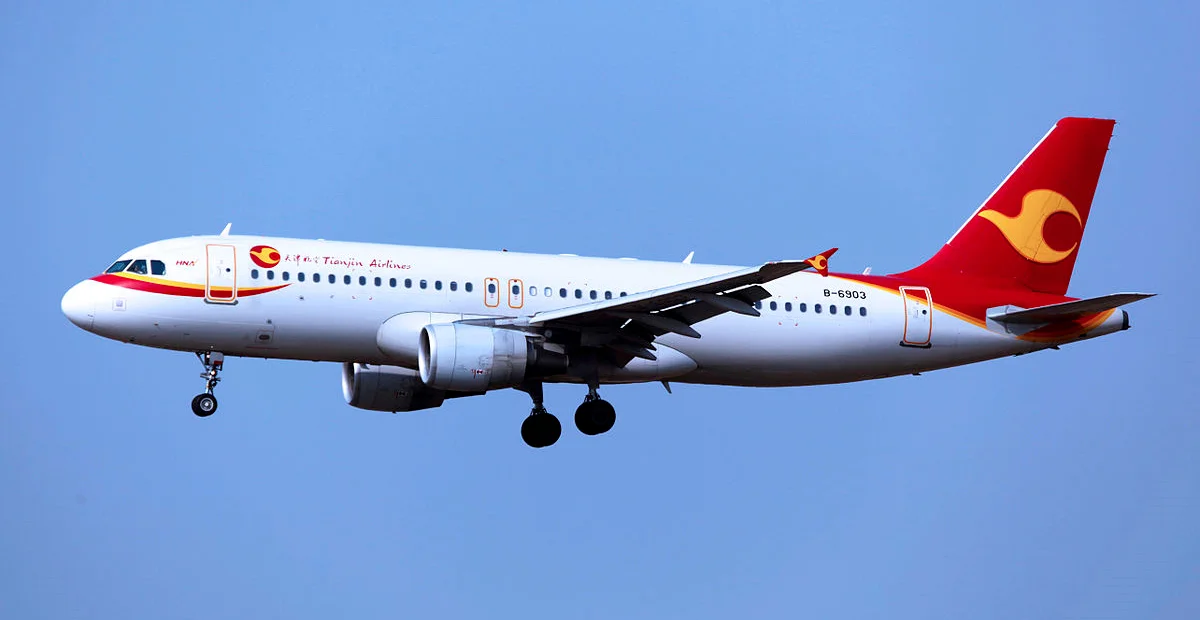Tianjin Airlines has established itself as a significant player in China’s aviation industry, evolving from a regional carrier to an airline with an expanding international footprint. Based in the economic center of the Bohai Economic Rim, this dynamic carrier connects major Chinese cities with destinations across Asia and beyond, while maintaining its strong regional network.
From Grand China Express to Global Ambitions: The History of Tianjin Airlines
Tianjin Airlines’ story began in 2004 when it was established as Grand China Express Air in an effort to merge major aviation assets of several airlines including Hainan Airlines, China Xinhua Airlines, Changan Airlines, and Shanxi Airlines. After receiving its operating license from the Civil Aviation Administration of China in 2007, the airline began scheduled flights, initially focusing on regional operations with smaller aircraft like the Dornier 328JET.
A significant milestone came on June 8, 2009, when the carrier was formally incorporated as Tianjin Airlines through a joint venture between HNA Group and the Tianjin Municipal People’s Government. This partnership underscored the strategic importance of the airline to the development of Tianjin as a transportation hub.
In its early years, Tianjin Airlines concentrated on developing a comprehensive domestic network, particularly in the regional markets of Xinjiang and Inner Mongolia. The airline established itself as a crucial link between regional capitals and various feeder airports throughout China.
A new chapter began in 2016 when Tianjin Airlines expanded into long-haul international services with the addition of Airbus A330 aircraft to its fleet. This expansion included the launch of routes to destinations such as Auckland in New Zealand, London-Gatwick in the United Kingdom, and Moscow-Sheremetyevo in Russia, marking the carrier’s evolution from a purely regional operator to an international airline.
By the Numbers: Tianjin Airlines Stats
Tianjin Airlines has grown significantly since its inception:
- Operates a fleet of approximately 85-100 aircraft
- Serves over 120 destinations with more than 290 routes
- Maintains eight operational bases across China
- Achieved over 1.8 million continued flight hours of safe operations
- Transported more than 14 million passengers in 2018
- Recognized as a SKYTRAX “World’s 4-Star Airline”
- Ranked first in on-time performance among major Chinese domestic airlines for three consecutive years (2016-2018)
Fleet Overview
Tianjin Airlines operates a diverse and modern fleet designed to serve various market segments:
Widebody Aircraft:
- Airbus A330-200 and A330-300: Used for long-haul international routes, featuring both business and economy class cabins
Narrowbody Aircraft:
- Airbus A320-200: The backbone of the fleet for domestic and regional routes
- Airbus A320neo: Next-generation aircraft offering improved fuel efficiency
- Airbus A321-200: Higher capacity variant for popular routes
Regional Jets:
- Embraer E190AR and E190LR: Serving shorter regional routes with approximately 106 seats
- Embraer E195LR: Larger regional jets with capacity for 122 passengers
This diverse fleet allows Tianjin Airlines to efficiently serve markets of varying sizes and distances, from short regional hops to long-haul international services.
Hub Cities: Tianjin Airlines’ Major Operations
Tianjin Airlines has strategically established multiple bases throughout China:
- Tianjin Binhai International Airport: Primary hub and headquarters location
- Xi’an: Key hub serving central and northwestern China
- Hohhot: Important base for Inner Mongolia routes
- Urumqi: Strategic hub for Xinjiang regional market
- Chongqing: Southwestern China hub
- Guiyang: Base serving southwestern markets
- Haikou: Hub for services to and from Hainan Island
- Dalian: Northeastern China operations center
This multi-hub strategy allows Tianjin Airlines to efficiently serve diverse markets across China’s vast territory while maintaining strong regional connectivity.
Route Network
Tianjin Airlines’ network encompasses both domestic and international destinations:
Domestic Network: The airline operates an extensive domestic network connecting major cities with regional centers throughout China. Particularly strong in the regional markets of Xinjiang and Inner Mongolia, Tianjin Airlines serves as a vital link between these areas and the rest of China.
International Network: Since launching long-haul operations, Tianjin Airlines has expanded its international presence with flights to destinations in:
- Asia: Japan, South Korea, and Russia
- Europe: United Kingdom
- Oceania: New Zealand and Australia
The airline continues to develop both its regional services and international routes, positioning itself as a bridge between China and the world.
Awards and Recognition
Tianjin Airlines has received numerous accolades for its service quality and operational excellence:
- SKYTRAX “Best Regional Airline in China” (2011)
- SKYTRAX “World’s 4-Star Airline” certification (2011)
- “AirlineRatings International Award – Most Improved Airline” (2017)
- Leading on-time performance among major Chinese carriers (2016-2018)
These recognitions reflect the airline’s commitment to providing reliable and quality service throughout its network.
Partnerships and Alliances
Tianjin Airlines is a member of the U-FLY Alliance, the world’s first alliance of low-cost carriers. While not part of the major global airline alliances, Tianjin Airlines maintains codeshare agreements with several airlines to extend its network reach and provide more seamless travel options for passengers.
The airline’s Fortune Wings Club frequent flyer program allows passengers to earn and redeem points across its route network and partner airlines.
Looking Forward
As air travel continues to evolve, Tianjin Airlines remains focused on balancing its regional expertise with international ambitions. The airline continues to modernize its fleet with newer, more efficient aircraft while expanding its route network both domestically and internationally.
With its positioning as Tianjin’s “Air Bridge” and the city’s “Business Card” for international engagement, Tianjin Airlines plays a vital role in connecting the economically significant Bohai Economic Rim with the rest of China and the world.
By maintaining its commitment to safety, service quality, and network development, Tianjin Airlines is poised to continue its growth trajectory as a key player in China’s dynamic aviation market, supporting the country’s economic development while bringing Chinese travelers to new international destinations.
Keyword: TopAirlines

